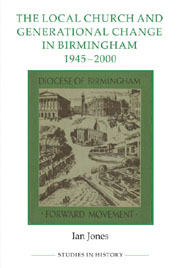Book contents
- Frontmatter
- Contents
- List of figures and tables
- Acknowledgements
- Abbreviations
- Map of Birmingham
- Introduction
- 1 Birmingham: the city and its churches
- 2 The spectre of ‘decline’
- 3 Church, youth and family from the 1940s to the 1960s
- 4 Life and worship in the local congregation
- 5 Church and neighbourhood: four congregational stories
- 6 Towards the margins: being Christian in a pluralist society
- Conclusion
- Appendix: Oral history
- Bibliography
- Index
2 - The spectre of ‘decline’
Published online by Cambridge University Press: 05 February 2013
- Frontmatter
- Contents
- List of figures and tables
- Acknowledgements
- Abbreviations
- Map of Birmingham
- Introduction
- 1 Birmingham: the city and its churches
- 2 The spectre of ‘decline’
- 3 Church, youth and family from the 1940s to the 1960s
- 4 Life and worship in the local congregation
- 5 Church and neighbourhood: four congregational stories
- 6 Towards the margins: being Christian in a pluralist society
- Conclusion
- Appendix: Oral history
- Bibliography
- Index
Summary
One of the most significant recent developments in the historiography of Christianity in modern Britain has been the search for new narrative frameworks which broaden the scope of debate beyond questions of institutional decline. As John Wolffe has argued, ‘a rounded account of the history of religion in Britain … needs to balance the language of decline and secularisation with an awareness of continuity, adaptation and new beginnings’. Nevertheless, declining church attendance remains an inescapable feature of the history of postwar Christianity. From around 40 per cent of the population of England and Wales in church on Census Sunday 1851, this figure had dropped to 7.5 per cent by 1998 and 6.3 per cent by 2006. In Birmingham, roughly 32 per cent of the population had attended church in 1892, but only 8.6 per cent by 1998 and 6.8 per cent by 2006. Although the bald statistics are familiar, less is known about the impact and interpretation of decline amongst those who remained in church. If decline is a cultural as well as statistical phenomenon, then exploring experiences of living with decline should be important to our overall understanding. As a result, this chapter seeks to provide a more rounded account of the experience of growth and decline in church attendance at grass-roots level. In so doing, it brings Birmingham church attendance statistics into conversation with perceptions of congregational strength or weakness derived from parish magazines and oral testimony.
- Type
- Chapter
- Information
- Publisher: Boydell & BrewerPrint publication year: 2012

